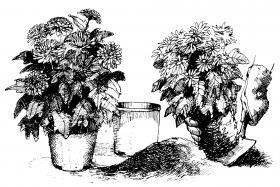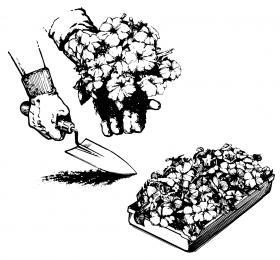Helpful hints on how to successfully plant your newly purchased nursery stock, specifically annuals and perennials.
Annuals and perennials can make a big impact on any garden. They bring colour and excitment to your home Here is a helpful guide on planting your new trees but as always our team is happy to answer any questions you have.
Your new plants should be installed as soon as possible. If there is some delay in planting, then it is important to guard against moisture loss. Store plants in a shady, wind-protected area, and keep the root area evenly moist.
Handle plants gently and use the container or rootball to move the plant. Never hold onto the plant itself. Be sure to place your plants in their preferred growing environment for the best results.
|
|
 |
| Plastic pots. |
 |
| Perennials and annuals. |
|
|
Water thoroughly before removing the container. If a light tapping on sides and bottom does not release the soil, make two cuts the length of the pot on opposite sides and gently pull away from the halves. Use your fingers or a knife to gently loosen and spread exposed roots that appear crowded. To free very matted or circling roots, make several vertical cuts 1/2- to 1-inch deep through the root mass.
These are usually grown in beds where 3 to 6 in. of sphagnum peat moss is spread over the surface and worked into the soil to a depth of 3 to 12 in. A good general-purpose flowering fertilizer can be added at this time. Thorough bed preparation is important for healthy perennials since they will be growing in that same location for many years to come. If a specimen is being planted or being added to an existing bed, then prepare the planting hole as you would for a tree or shrub.
|
Roses may be in fibre or plastic pots. Most roses are grafted on to different rootstock. For reasons of hardiness, the grafted area (which will be the swollen area where the stems originate) must be planted two inches below the soil. For rhododendrons, azaleas and other broad-leafed evergreens, increase the amount of sphagnum peat moss used by half. Peaches, nectarines and cherries demand excellent fast-draining soil. DO NOT plant in wet areas. DO NOT overwater.
Plants grown in plastic pots tend to dry out more quickly, therefore, more frequent watering may be necessary to avoid plant wilt. It takes several weeks for roots to extend beyond the original soil ball, so be sure to check this area as it often dries out faster than surrounding garden soil. Deep watering encourages a deep root system and your plant will become more drought tolerant.
Apart from their good appearance and the retarding of weed growth, mulches help to retain moisture. Mulch also keeps roots cool in summer and insulated in winter. Maintenance is easier and your plants will thrive.
- Divert downspouts and sprinklers away from the planting area.
- Water only when the soil feels dry to the touch, 2 to 3 in. down into the root area. Continue this form of watering until the plant is well established and growing.
- A good soil mix is 50 per cent soil, 25 per cent peat moss, 25 per cent compost or manure.